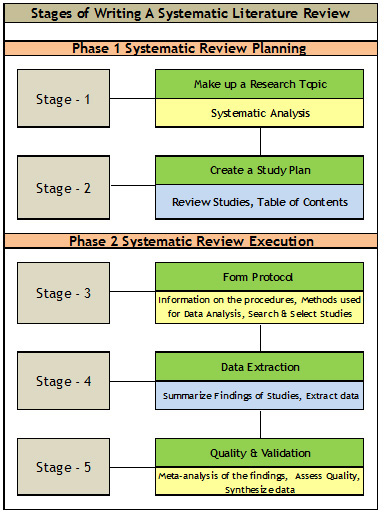A systematic analysis is a study that looks at a lot of different research. To address a particular research query, it attempts to collect all available information on a specific subject. Before beginning the systematic review, the authors provide guidelines for determining which evidence should be included or omitted. This reduces the chance of bias and improves the reliability of the results.

A Systematic literature review is a multi-stage method that can be published in the form of an original research article of the same name. Systematic evaluations should include the following:
- Explicitly state the goals
- Attempt to classify all studies that meet the eligibility requirements through a rigorous search strategy
- Determine the validity of the results of the included studies
- Synthesize the findings of the studies in a systematic way
What are the Steps in a Systematic Literature Review?
Phase 1 Systematic Review Planning
Make up a research topic
- Before you begin your project, consider whether a systematic analysis is needed.
- Determine if you have enough time and money to perform a thorough analysis. Keep in mind that finishing it could take longer than a year.
- Form a team of collaborators to assist you.
- Put your subject into the “Well-Built Clinical Question” structure to start your systematic analysis.
Create a Study Plan
- Select your Review Studies.
- By screening titles/ abstracts, you will be able to reject those who don’t fulfill your inclusion criteria.
- Clearly describe the review methodology and eligibility requirements.
- A thorough search should be conducted.
- Make a table of contents you will read in detail and those that will be rejected.
Phase 2 Systematic Review Execution
Form Protocol
- A research protocol is a step-by-step plan for investigating a biomedical or health-related issue and formulating the Problem
- The goals of your research, information on the procedures and processes that will be used, eligibility requirements for individual studies, how data will be collected from individual studies should be included in your systematic review protocol.
- Review the literature to make sure it has not been done before.
- Form a Hypothesis and give the review a title.
- Describe the steps that will be followed by the Reviewer
Data Extraction
- Summarize findings of studies reviewed in a form of a table with References, Study Parameters, Focus, Gap, Findings.
Quality & Validation
- Methods for Quality Evaluation of the Review Studies have an impact on the conclusion, so it is necessary to avoid any bias.
- Make a table of research.
- Analyze data for issues including heterogeneity (differences between studies) and sensitivity of results.
- Consider doing a meta-analysis of the findings.
- Make a list of studies that were omitted accessible to interested readers.
Conclusion
Systematic literature reviews are widely regarded as one of the most effective tools for summarising and synthesizing evidence related to a particular research topic. A systematic literature review aims to classify, critically appraise, and summarise the current evidence concerning an identified issue, similar to conventional literature reviews.


